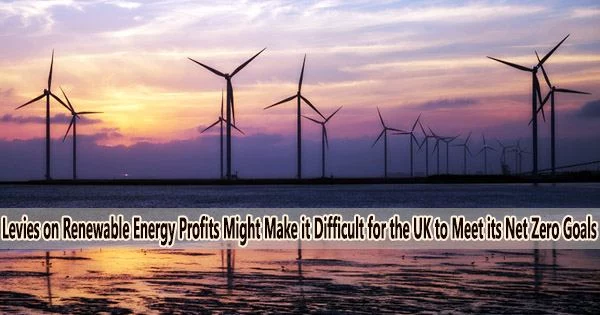An expert has warned that levies on the profits made by the renewable energy sector could make it more difficult for the UK to achieve its 2050 net zero carbon reduction targets.
Gas continues to dominate the sector in terms of pricing despite the considerable development of low-carbon technologies on a global basis. Because the cost of electricity and gas are correlated, when the cost of gas rises, so does the cost of power.
This means that even while the cost of producing low-carbon energy did not increase considerably, some renewable energy producers will have lately benefited from a significant gain in revenues during the cost-of-living crisis.
This anomaly has prompted reaction from the Government in the form of introducing the ‘cost-plus revenue limit’ which is a revenue cap on specified low carbon generators in the Energy Prices Act 2022, which has then subsequently been replaced with a 45 per cent levy.
Dr. Catherine Caine from the University of Exeter Law School, has analysed the impact of the recent Energy Prices Act and levy on specified low carbon electricity generators. The study is published in the Environmental Law Review.
The addition of the cost-plus-revenue restriction on certain low carbon sources was one of the Energy Prices Act’s most contentious provisions. This was created with the intention of giving the Secretary of State the authority to cap the amount of money raised by particular low carbon generators who are not already covered by a contract for difference.
It seems, for now at least, that fossil fuels remain to be the driving force when it comes to energy prices, and that whilst the recently introduced measures aimed at tackling the prices of electricity generated from low carbon sources will provide some comfort to consumers, more work is needed in the long term to reform electricity markets to sever the price link between gas and electricity.
Dr. Catherine Caine
However, shortly after the Act was introduced, the Government announced an alternative plan to apply a 45 per cent levy to specified low carbon generators instead. This proposal has proven unpopular with industry leaders.
The government wants to cap low-carbon energy producers’ earnings through the 45% levy and encourage producers who aren’t already bound by a contract for difference a long-term arrangement that guarantees the low-carbon energy producer a set price for the duration of the contract to do so.
The government claims that this tax, which is levied against those who make “extraordinary profits” from the electricity produced by nuclear, renewable, and biomass sources, is a more equitable measure that will give generators a larger portion of their profits to put toward expanding the UK’s capacity for renewable energy.
Low carbon energy producers will also have the option, if they are not already bound by one, to enter into a voluntary contract for difference in addition to the 45% charge.
Dr. Caine said: “This new voluntary contract for difference offering will allow renewable energy generators who were not able to obtain a contract for difference initially to sign up to one from 2023. However, the success of the scheme will largely depend upon the strike price that the government is willing to offer on the new voluntary contracts.”
“There is now a real fear that the introduction of the 45 per cent levy could undermine investor confidence and could potentially lower the number of low carbon generators who choose to develop in the UK, thus potentially hindering the UK’s ability to meet its 2050 emission targets. Whilst the Government has been very keen to stress that the levy is temporary and proportionate it will inevitably cause a change in existing contracts for low carbon generators who are not currently subject to a contract for difference.”
“It seems, for now at least, that fossil fuels remain to be the driving force when it comes to energy prices, and that whilst the recently introduced measures aimed at tackling the prices of electricity generated from low carbon sources will provide some comfort to consumers, more work is needed in the long term to reform electricity markets to sever the price link between gas and electricity.”
















